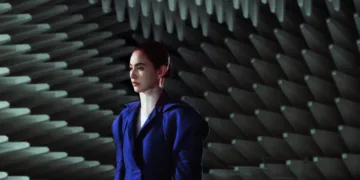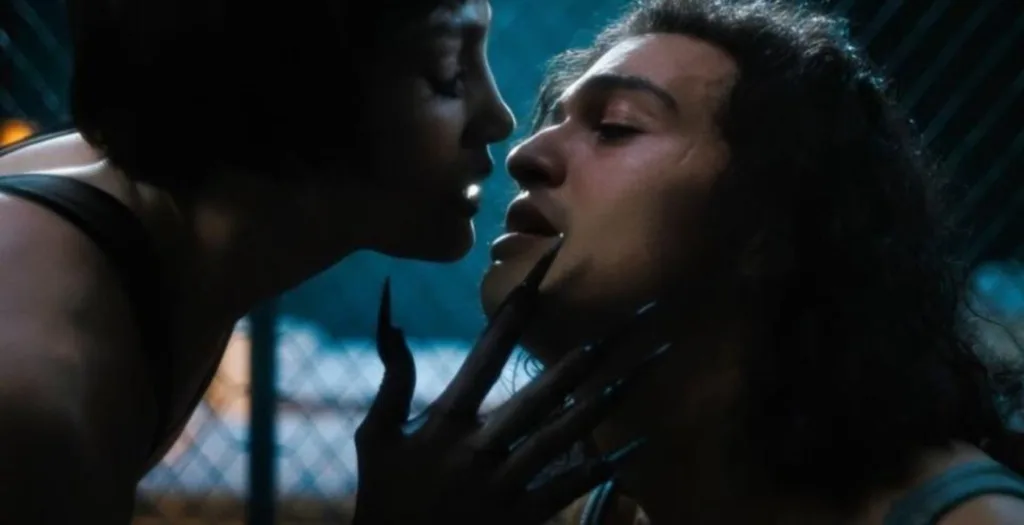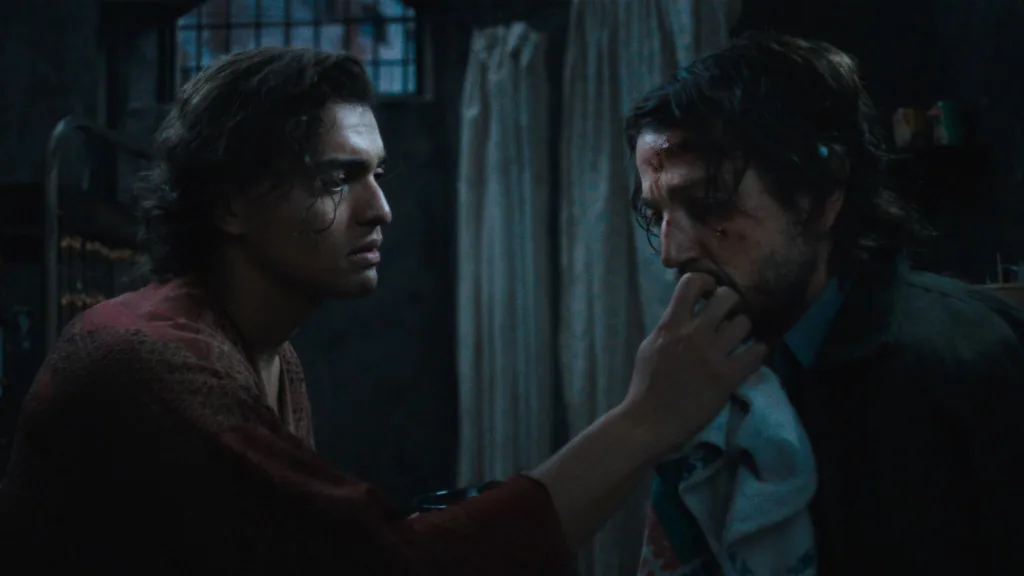In 1983 Argentina, under the harsh military dictatorship during the Dirty War, Kiss of the Spider Woman unfolds its story within a prison cell. The setting operates as a stark representation of societal control and human endurance. Luis Molina, a gay window dresser imprisoned for public indecency, shares his cell with Valentin Arregui Paz, a Marxist revolutionary tortured for opposing the regime. Their shared confinement becomes a space where different worldviews clash and eventually merge.
Molina’s imaginative narratives emerge as a survival strategy, deeply connected to Latin American interpretations of classic Hollywood cinema. His fixation on Ingrid Luna, a fictional screen actress representing cinematic archetypes, transcends simple distraction. These stories reveal how global cultural elements are transformed through local perspectives to create complex personal identities. Director Bill Condon weaves a narrative that shifts between harsh prison reality and vivid cinematic dreams, showing how storytelling becomes a form of psychological resistance.
The interaction between Molina and Valentin explores complex human connections. They challenge traditional boundaries of gender, sexuality, and political ideology through their intimate dialogue and gradual understanding of each other’s experiences. Their relationship reveals the nuanced ways individuals negotiate survival, identity, and connection under extreme political oppression.
Theatrical Echoes and Cinematic Dreams: The Musical Soul of Kiss of the Spider Woman
Jennifer Lopez electrifies “Kiss of the Spider Woman” through her mesmerizing performance as Ingrid Luna, Aurora, and the Spider Woman. Her portrayal captures the essence of classic Hollywood divas while introducing a vibrant Latin American perspective.
Lopez transforms her roles with remarkable depth. As Ingrid Luna, she channels cinematic icons like Rita Hayworth and Cyd Charisse, breathing new life into the archetype. Her vocal performance during “She’s a Woman” reveals emotional complexity, expressing vulnerability and passion that echo Molina’s inner world. In “Gimme Love,” she reimagines Marilyn Monroe’s seductive persona with contemporary confidence and self-possession.
Colleen Atwood’s costume design amplifies Lopez’s character transitions. Aurora appears in sleek, vintage-inspired gowns reminiscent of Edith Head’s designs. The Spider Woman emerges in a glittering black-and-silver webbed outfit that blends theatrical drama with sinister allure. These visual transformations highlight the character’s multifaceted nature.
The film’s musical numbers create powerful narrative moments. “She’s a Woman” explores cinematic idolatry while revealing Molina’s internal struggles. “Gimme Love” interweaves energetic choreography with sharp commentary on gender representation. Director Condon’s approach emphasizes wide shots and deliberate framing, allowing audiences to appreciate intricate choreographic details.
The production crafts a rich dialogue between nostalgic Hollywood aesthetics and contemporary themes of identity and expression. Lopez’s performance stands as a magnetic centerpiece, inviting viewers into a world where fantasy and personal truth intersect with electrifying intensity.
Parallel Lives, Converging Paths: The Dynamic Duo of Molina and Valentin
Tonatiuh’s portrayal of Luis Molina delves deep into the character’s complexity, exploring a persona that exists between societal edges and personal imagination. His Molina emerges as a nuanced character whose theatrical movements hide intricate emotional landscapes. In one moment, he moves about their shared cell with restless energy; in another, his voice trembles when describing the adventures of his beloved screen idol, Ingrid Luna. This complexity becomes vivid during musical moments, where Tonatiuh’s vocal performance exposes layers of unexpressed yearning and resistance.
The musical sequences transform beyond Hollywood tributes—they become declarations of identity and suppressed dreams under Argentina’s oppressive system.
Molina’s journey from disengaged prisoner to committed ally unfolds with exceptional precision. Initially indifferent to Valentin’s political passion, Molina gradually becomes someone willing to challenge dangerous circumstances for connection and support. This transformation feels authentic, rooted in Tonatiuh’s ability to create genuine emotional landscapes.
Diego Luna presents Valentin Arregui Paz with electric precision, crafting a revolutionary character with profound human depth. Valentin initially appears staunchly ideological, his masculine exterior seemingly disconnected from Molina’s sensibilities. Luna reveals a multilayered individual wrestling with internal conflicts and unexpected emotional openness.
Their relationship creates a powerful narrative thread, moving between conflict and intimacy. Luna and Tonatiuh generate electric interactions that challenge traditional narrative expectations about connection under extreme circumstances.
Shadows of Power, Echoes of Identity: The Dual Themes of Oppression and Queerness
The portrayal of Argentina’s military dictatorship in Kiss of the Spider Woman serves as a critical narrative framework, connecting the story to the raw experiences of political repression. During the Dirty War—a period defined by forced disappearances and state terror—the film contrasts Valentin’s revolutionary struggle with Molina’s escapist visions. Director Bill Condon creates a complex study of resistance and survival.
Valentin’s Marxist beliefs represent collective defiance against authoritarianism. His silence under torture reveals the human price of political engagement, making his physical and emotional breakdown deeply moving. The film deepens this narrative through Molina’s fantastical film descriptions. When Molina recounts Ingrid Luna’s story of love and betrayal, its melodramatic tones echo Valentin’s situation: trapped between political commitment and his connection with Molina.
Molina’s character explores gender identity, queer relationships, and societal expectations. The film subtly suggests his transness, especially when he expresses desire to embody the women he sees onscreen. His statement “I wish that she were me” during “She’s a Woman” speaks to a profound sense of self-expression.
The relationship between Valentin and Molina challenges gender norms. Valentin’s initial machismo gives way to emotional vulnerability, while Molina resists societal constraints. They create a connection that defies traditional relationship categories, presenting queer intimacy within a context of systemic violence.
The film explores how power structures shape individual experiences, questioning art’s capacity to provide comfort without losing sight of painful realities.
Realms of Despair and Dreams: The Cinematic Dichotomy of Kiss of the Spider Woman
The depiction of prison life in Kiss of the Spider Woman presents a raw portrayal of suffering under Argentina’s military dictatorship. Cinematographer Tobias Schliessser uses muted colors—grays, browns, and dull blues—to capture the prison’s oppressive atmosphere. The handheld camera work intensifies the feeling of confinement and instability, creating an intimate view of the characters’ experiences. One sequence shows Valentin writhing on the cell floor after being poisoned, with shaky framing that makes his pain feel immediate and raw.
These visual techniques create a powerful contrast between the prisoners’ stark reality and their inner worlds. The cinematographic approach carefully balances between harsh realism and subtle visual nuance, exploring the psychological landscape of imprisonment.
The film’s fantasy sequences offer a dramatic counterpoint to the prison’s bleakness. Production designer Scott Chambliss creates vibrant sets with art deco and art nouveau elements—plastic furniture, bright duvets, and sweeping arches that transport viewers into Molina’s imaginative realm. Jennifer Lopez’s character, Aurora, moves through these spaces with exaggerated glamour, embodying a cinematic dream world.
The stark difference between the prison’s muted palette and the fantasy sequences’ vivid colors creates a compelling visual dialogue. Each realm speaks to different aspects of human survival: the brutal reality of political oppression and the mental escape provided by imagination.
These contrasting visual languages explore how individuals construct inner worlds when external circumstances become unbearable, revealing the complex relationship between survival, fantasy, and human resilience.
Reimagining the Spider’s Web: Condon’s Vision and the Adaptation Paradox
Bill Condon’s approach to adapting The Kiss of the Spider Woman focuses on a singular fictional narrative, departing from his previous multi-layered storytelling. By concentrating Molina’s narrative lens, Condon crafts a unified story that explores the connections between reality and imagination. This strategy allows for a deeper examination of the film-within-a-film’s dramatic elements while occasionally simplifying the nuanced layers of Manuel Puig’s original text.
Condon navigates these artistic tensions with varying degrees of success. His musical staging draws inspiration from classic Hollywood cinema, employing wide camera angles and intentional choreography reminiscent of vintage film techniques. The stylistic choices sometimes create tension with the stark prison environment, producing unexpected dramatic contrasts. The transition between Valentin’s painful experiences and Molina’s fantastical sequences can feel disruptive. Nevertheless, certain moments—particularly the title song—merge theatrical artifice with emotional authenticity.
Examining this adaptation against its source materials reveals a complex interplay of fidelity and creative interpretation. Terrence McNally’s stage version highlighted Molina’s queer identity, while Condon introduces subtle explorations of gender dynamics. The translation from stage to screen presents its own artistic challenges, questioning how intimate theatrical moments can be effectively rendered cinematically. Condon selects a restrained visual approach that differs from more extravagant musical adaptations, creating an intriguing dialogue between theatrical tradition and cinematic expression.
The Review
Kiss of the Spider Woman
"Kiss of the Spider Woman" presents a nuanced cinematic experience that intertwines political tension with theatrical storytelling. Jennifer Lopez delivers an electrifying performance alongside Tonatiuh's deeply sensitive portrayal of Molina. The film navigates complex themes of personal identity and societal resistance through a multilayered narrative. Bill Condon's direction wrestles with tonal shifts between dramatic realism and theatrical fantasy. Despite occasional narrative inconsistencies, the movie offers a rich exploration of human connection and survival under oppressive conditions. The cinematic work probes the intersections of personal imagination and political reality, creating a textured portrait of two characters bound by unexpected intimacy. Lopez and Tonatiuh craft nuanced characters who challenge traditional boundaries of friendship and solidarity.
PROS
- Jennifer Lopez delivers a standout performance, showcasing her singing, dancing, and acting talents.
- Tonatiuh’s portrayal of Molina is heartfelt and nuanced, bringing depth to the character.
- The film’s visual contrasts between gritty prison realism and vibrant musical fantasy are striking.
- Bill Condon’s direction successfully integrates metafictional elements, enhancing the narrative’s complexity.
- Strong thematic exploration of identity, oppression, and queer relationships resonates with contemporary audiences.
- Diego Luna brings emotional intensity and authenticity to his role as Valentin.
CONS
- The tonal shifts between harsh reality and escapist fantasy can feel uneven or jarring at times.
- Some songs struggle to assert themselves and lack memorability compared to other Kander and Ebb works.
- The prison scenes occasionally veer into staginess, undermining their intended realism.
- The film’s pacing falters in the final act, diluting the impact of its tragic conclusion.


















































